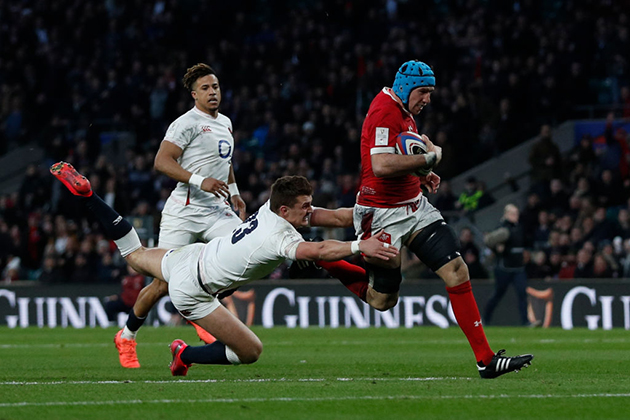In the latest in his series, Sam Larner looks at how England and Wales scored tries from first phase at the weekend
Six Nations Analysis: First-phase attack
We tend to remember those long defensive stands where teams hold out against phase upon phase of relentless attack. You only need to look back a year to Wales v England in the Six Nations when Cory Hill scored after 30-plus phases. Those tries may live long in the memory but they are a rarity. It is far more common for tries to come off first phase.
Before we go any further, it’s time we clarify what is meant by a phase. Every time an attacker is tackled the phase count goes up by one. That count rises until they score or the ball is handed to the opposition at which point their phase counter starts.
When we say first phase, we mean the first time the attack have an opportunity to attack with the ball. Typically this is from a lineout or a scrum, but could also be from a kick-off or turnover.
Dan Biggar scored off first phase for Wales’ second try against England…
Finding a way to the line…#GuinnessSixNations pic.twitter.com/S6vVnEVbMf
— Guinness Six Nations (@SixNationsRugby) March 7, 2020
At this point England were down to 13 men due to the Manu Tuilagi red card and Ellis Genge’s yellow. This causes clear problems for them because they cannot cover all the Welsh attacking options.
They could have matched the back-line by reducing the numbers in their scrum to six but then they may just be pushed over the line by Wales. Instead they go for seven in the scrum and six defending the backs.
It is interesting to see George Ford’s role. He is defending the blindside but he is going to dart to the openside as soon as it is clear that Wales won’t attack the blindside. He moves across nicely but Wales move the ball quicker and the defence cannot react.
Henry Slade finds himself caught between stopping Nick Tompkins and drifting onto Biggar. England run out of numbers and Biggar rides the Slade tackle to the line.
MORE SIX NATIONS ANALYSIS
Six Nations Analysis: Finishing
In the second feature in this new series,…
Six Nations Analysis: The Last Pass
The opening round of the Six Nations showed…
Six Nations Analysis: Targeting Individual Defenders
Sam Larner uses examples from the latest round…
Wales’ numerical superiority allowed them to overload the defenders with options. The two cards made this a unique situation but attacking teams will always try to do it from first phase of a set-piece. They can run a practised move that is designed to exert pressure on a certain part of the defence. That isn’t the case in open play.
England were able to score a first-phase try of their own earlier in the match for the opening try…
Natural. Born. Tryscorer
Welcome back @anthonywatson_!#ENGvWAL #GuinnessSixNations pic.twitter.com/v9wybmftqx
— Guinness Six Nations (@SixNationsRugby) March 7, 2020
Lineouts are harder to attack from because you can really only attack one way – away from the lineout. The defenders therefore set up to push the attackers wide, which can cause some problems.
England set-up a fake maul, which draws the Welsh forwards to one place. Tom Curry is playing the part of the scrum-half, which allows Ben Youngs to move into the fly-half position. This set-up is increasingly common because it allows your fly-half to stand in the middle of the pitch and provide an immediate wide threat.
Wales identify this and their backs look to close down the Ford threat in the midfield. Curry follows his own pass, which drags the players marking him over. That expands the hole in the Welsh defence and Youngs pulls the pass back towards Anthony Watson, who finishes with some exceptional footwork.
Rather than put pressure on the wide channel, England threatened wide and opened up the defence close to the lineout. It was classic misdirection: show one threat and then attack a weakness the defence didn’t know they had.
We have talked about set-piece first phase tries up to this point but the best try of the weekend, and arguably of any Six Nations, came from a kick-off.
One of the greatest tries the #GuinnessSixNations has EVER seen#ENGvWAL pic.twitter.com/QskEGowmaw
— Guinness Six Nations (@SixNationsRugby) March 7, 2020
Kick-offs are generally not returned for tries. The reason for this is that the kicking team know where the ball is going and can chase to pin the receivers in that spot.
In this example, England tried to do just that. Elliot Daly charges after the kick with George Kruis and Mark Wilson either side of him. When Tompkins receives the ball he has Daly bearing down on him.
With someone moving that quickly, it is easy to step them and when Tompkins does that he just needs to get past Kruis before Wales can create a line break.
Tompkins cuts infield to create a wider running lane for Josh Navidi on the outside. Navidi then cuts infield again to fix two defenders and give the ball back to Tompkins. From there it’s just a succession of two-on-ones that puts Justin Tipuric under the posts.
England played a high-risk hand. If Daly had caught Tompkins with the ball then Wales would have been in their own 22 and possibly looking at a turnover. When Tompkins avoids the tackle the English defence is just a succession of individuals that Wales can slice through.

Full stretch: Anthony Watson scores England’s first try from a lineout move (Getty Images)
Conclusion
First phase provides a great attacking opportunity. From set-piece, you get to place your attackers however you wish. This allows you to put pressure on defences who have to react to your training-ground move. It is no wonder that set-pieces provide such fertile attacking ground.
From kick-offs or turnovers the attack may not know where the ball is going to go but the defence are suddenly thrown into a situation they didn’t expect. The Tipuric try is a perfect example: England expected to pin Wales in their own 22 but suddenly they were facing a rampaging Wales.
Watch out for how Wales and Scotland deal with both attacking and defending off first phase in their final match of the Six Nations on Saturday.
The April issue of Rugby World magazine – focusing on a new generation of Six Nations stars – is out now.
Follow Rugby World on Facebook, Instagram and Twitter.








